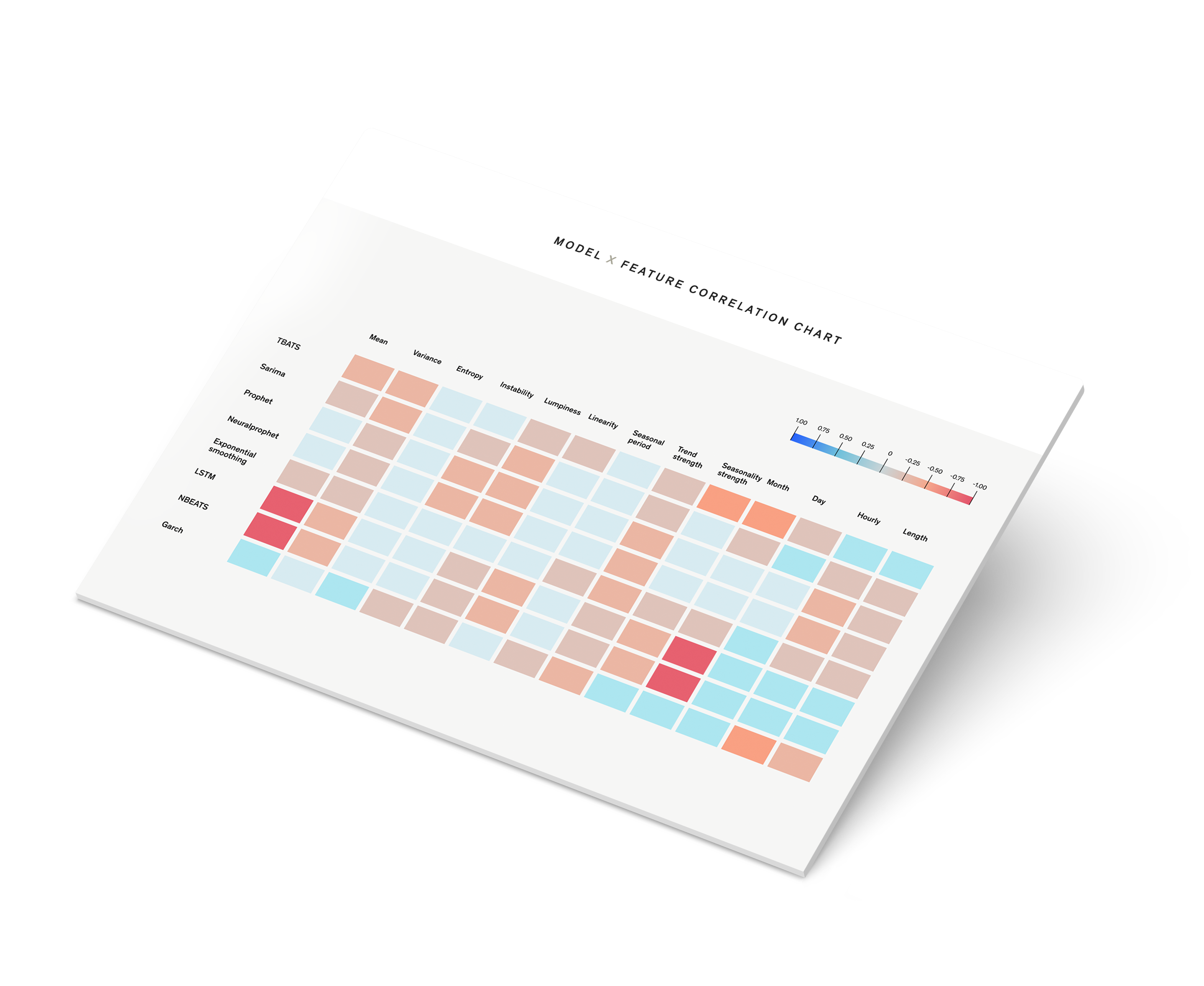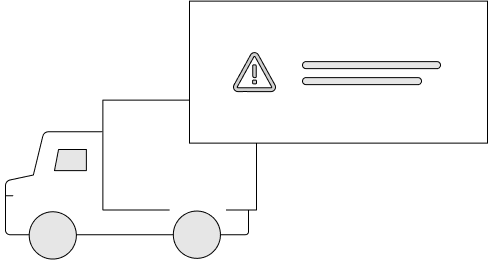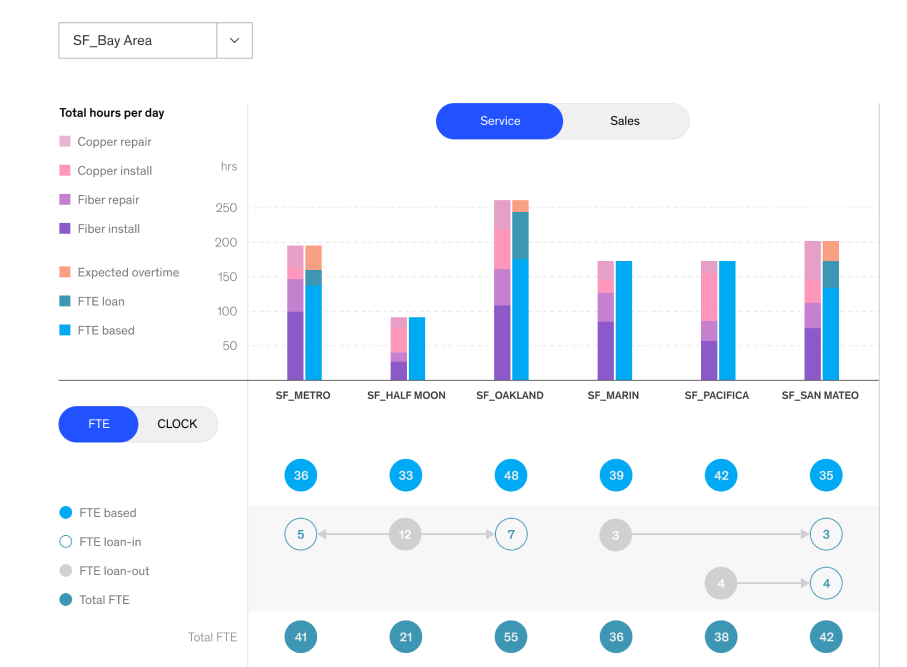Technology
Built from the ground up
Frontline.ai’s workforce management tools allow employees at all levels to be much more effective with more accurate forecasting, workforce optimization, and actionable insights. All packaged in easy-to-use UI, which can be seamlessly integrated into your existing systems.

Frontline.ai’s suite of workforce management solutions are underpinned by a series of proprietary technologies

Proprietary AI Technologies
Forecast
AI-powered forecasting across demand and supply variables for monthly, daily, and interval time horizons
Simulate
Digital twin simulations that model the workforce to create highly flexible and accurate scenario analyses
Schedule
AI-enabled engine that optimally matches supply to demand at any time interval with full flexibility in business constraints and optimization targets
Frontline.ai's customizable forecast engine delivers best-in-class accuracy across variables over time at a granular level with actionable, detailed insights and a feedback loop to drive improvement and combat natural model decay. It can be fully integrated into your existing tech stack and systems.
Time-series training pipeline structure:
Data Cleaning
Automated data pre-processing designed for time-series data. This step includes automated outlier identification and replacement as well as machine learning driven smoothing.
Summarizing time-series features and components
Decomposing the time-series into trend and seasonality and calculating different metrics to quantify the level of noise and irregularities across multiple dimensions.
Automated model selection
Shortlist the range of models to be applied to every time-series based on the time-series metrics. This will enable a more targeted modeling approach, leading to higher accuracy and lower run-time.
Model validation and hyperparameter tuning
Leverages Bayesian-optimization to select the best set of hyperparameters for every model by leveraging multiple validation approaches. We use ensemble methods to ensure that the strength of every model is incorporated to increase the overall performance.
Post-processing and bias adjustment
Automated adjustment of one-off events (e.g., Black Friday) that cannot be captured through the machine learning models.
Automated Model Selection
Reducing model runtime
Automatically search within the universe of multivariate and univariate models to narrow the options for a more efficient training procedure. Allows for timely identification of the best model based on the time series features.

The model-feature correlation chart helps visualize the comparative performance of different models with regards to features of the time series. Negative correlation means the time series feature being prominent negatively impacts model performance and accuracy compared to other models.
In this example, while there is a higher concentration for exponential smoothing and prophet, every model has at least one example where is it the best option to use.
This transforms the process of forecasting in organizations
From
Approximately 15k lines of code has to be written with at least 16 weeks of 2 data scientist’s effort.
Data science workflow defined from scratch (e.g. splitting into training/test datasets, cross-validation strategy, etc.)
Ad-hoc model exploration and development of forecast generation functions, requiring significant knowledge of forecasting models and time investment.
Single-threaded application with low computational performance
To
Simplified API which reduces data science work to ~1000 lines of code and 4 weeks of development time for 2 data scientists.
Standardized data science steps with flexibility to adjust components such as testing period, number of cross validation folds, hyperparameters to test, etc.
Ability to test various forecasting models using codified model API at varying granularities to generate daily, monthly and intra-day forecasts with playbook for highest impact levers.
Multiprocessing functionality for significantly quicker tuning iterations and forecast generation time to achieve higher accuracy and scale.
Scheduling technology comprises geographic & non-geographic AI engines that utilize accurate AI forecasts of supply & demand, to optimize shift schedules & geographic job routing to meet any given business objective (e.g. cost). Technology is fully flexible to incorporate business constraints and optimization targets.
Geographic optimization
This AI engine leverages linear programming to optimize schedules for jobs at varying locations for:

working hours
Constrains schedules to the available FTE & overtime hours at a site level.

No overlap between jobs
Ensures each job is completed within its target completion window before next job is allocated.

Job priority
Flexible to prioritize certain jobs above others based on importance to client

Client specific job constraints
Ability to prioritize completion of jobs based on client required constraints (e.g. those that are ongoing with a third-party, within their completion window, already started or closest to due date)

Idle time and travel time
Minimizes total idle time of all employees by optimally allocating jobs and loaning employees around different work centers
Schedule creation follows a three-step optimization process

Job Prioritization
We prioritize certain work orders, e.g:
- Ongoing with third parties (customer, service, etc.)
- Started a previous day
- In completion window
- Closest due date
Job to team matching
This is carried out via three methodologies:
- Scoring
- Cluster
- Overtime
Uses scoring functions to determine the optimal crew for the job
Shuffling techs across offices within the same cluster after meeting tech’s home office’s demand
Accommodating extra work hours for techs to complete jobs for a day
Intraday Shuffling
Lastly, our engine leverages mixed integer programming to minimize idle time by optimizing schedules for:
- Travel time
- Idle time
- While still verifying constraints of coordinated times and precedence
Non-geographic optimization
Schedule optimizer leverages AI-enabled algorithms to automate the creation of fully optimal schedules & shift patterns

Input
Demand inputs
- Call volume, average handle time, and shrinkage forecast
- Mapping of demand to role types
Our extremely high accuracy AI-generated forecast enables schedule optimization at a much more granular level
Supply Constraints
- Labor Laws
- Collective bargaining agreements (CBA)
- FTEs and PTEs available
Constraints are automatically validated, and user can input multiple constraint assumptions to model alternative scenarios (e.g. how much contract labor is used, or what the minimum shift lengths are)
Engine
Schedule optimizer
Linear programming based solver
Allocates supply to demand while minimizing scheduling cost
Our extremely high accuracy AI-generated forecast enables schedule optimization at a much more granular level
Output
Optimized Schedule Output
Results of optimized schedules can be compared across multiple scenarios to assess best course of action
Visual dashboards of optimized output enable user to make critical operational decisions on scheduling, workforce allocation, and further test alternative scenarios
Non-geographic optimization
Schedule optimizer leverages AI-enabled algorithms to automate the creation of fully optimal schedules & shift patterns
Input

Demand inputs
- Call volume, average handle time, and shrinkage forecast
- Mapping of demand to role types
Our extremely high accuracy AI-generated forecast enables schedule optimization at a much more granular level
Supply Constraints
- Labor Laws
- Collective bargaining agreements (CBA)
- FTEs and PTEs available
Constraints are automatically validated, and user can input multiple constraint assumptions to model alternative scenarios (e.g. how much contract labor is used, or what the minimum shift lengths are)
Engine
Schedule optimizer
Linear programming based solver
Allocates supply to demand while minimizing scheduling cost
Constraints are automatically validated, and user can input multiple constraint assumptions to model alternative scenarios (e.g. how much contract labor is used, or what the minimum shift lengths are)
Output
Optimized Schedule Output
Results of optimized schedules can be compared across multiple scenarios to assess best course of action
Visual dashboards of optimized output enable user to make critical operational decisions on scheduling, workforce allocation, and further test alternative scenarios
Schedule optimizer can massively improve and streamline the process of workforce management across multiple dimensions
From
- Schedules optimized locally at each individual office level and purely based on volume
- Manual processes required to break down demand at office and interval level based on historical data
- Manual enforcing and validation of restrictions
- Limited ability to understand the impact of self-imposed limitations and model alternate scenarios
- Limited ability for the scheduling team to respond/adapt to ad-hoc requests from stakeholders given manual processes
- Limited ability to adjust schedules to changes in demand once schedules are locked (5 weeks before ‘day of’)
To
Improve robustness of methodology
- Limited ability to understand the impact of self-imposed limitations and model alternate scenarios
Fully automated solution to minimize the risk of errors
- Automatic demand forecast by office at 15 minute time intervals for maximum accuracy
- Fully automated validation of documented restrictions and constraints (e.g. maximum allowable shift lengths)
Ability to model & edit multiple scenarios available easily & quickly
- Ability to create what-if analyses to evaluate business decisions and potential dollar value generated through different options
Full end-to-end solution enables rapid iteration & adaption to real-world
- Ability to quickly analyze and execute on ad-hoc requests from stakeholders or leadership
- Ability to adapt in an agile way to changes in demand up to 7 days before ‘day of’
An AI-powered solution that enables organizations to improve the performance of front-line employees through dashboards, personalized nudges, advice on training and peer-recognition.
Our technology determines the next best action for supervisors to take, and sends nudges directly to employees
SAIC architecture (simplified)



Team Huddle
Local Manager
AI coach proposes topics to bring up during team huddles based on topics relevant to multiple employees on the team


Action Nudge
Employee
AI coach sends nudges about certain metrics (e.g. time at garage and driving time)



Coaching
Local Manager
Supervisor receives information on most impactful area of improvement for employees (e.g., misdiagnosis of issues, avoidable equipment swaps), which they can use to better coach them


Action Nudge
Employee
Employee receives a nudge before a job, reminding them to perform compliance checks along the way



Best Practices Nudge
Employee
AI coach can send best practices ahead of time to help an employee complete tasks that have historically been challenging (e.g., connecting customers at the hub)


Coaching
Local Manager
Supervisors receive a prioritized summary of key areas of improvement for employees on their team, e.g., how to install a set-top box

Why do we need AI-enabled Coaching?
AI-enabled coaching provides a holistic and integrated approach, that can close the gaps present in regular coaching methods.
Frontline.ai’s UI technology provides data-driven dynamic business reports, abstracting away the back-end complexities and allowing users to focus on strategic insights and decision making
Intuitive UI for simplifying complex analysis
Graphs and other intuitive UI elements enables quick analysis of workforce allocation and requirements across multiple timeframes



Workforce type and time spent for different service types across multiple regions
Allocation of workforce across regions to optimally meet demand

Intuitive UI for simplifying complex analysis
Graphs and other intuitive UI elements enables quick analysis of workforce allocation and requirements across multiple timeframes
- Workforce type and time spent for different service types across multiple regions
- Allocation of workforce across regions to optimally meet demand
Scenario comparison
Easily select multiple scenarios to visualize long-term, mid-term, and short-term workforce needs

Save & Load Scenarios
Easily create, save and load scenarios, enabling informed decision making for workforce management
Create Scenario
Using AI-driven projections, create different scenarios by providing setting values through an intuitive interface

Save Scenario
Save scenarios for future use

Load Scenario
Load saved scenarios and apply them to different regions and for different dates

Frontline.ai offers a fully cloud-native software-as-a-service model, but we can also support a fully client-hosted implementation based on your preference
Our automated cloud infrastructure provides the following significant benefits:
Lower cost
Computing provision is fully flexible & scalable based on real-time demand.
Security
Fully compliant & rigorously tested cloud infrastructure is the most secure method for data transfer, storage & processing.
Lower complexity
We manage all the infrastructure for you, leaving you to focus on the insights & core business objectives.
Speed of deployment
Pre-built architecture is ready to go from day 1, meaning less time to reach insights and realize performance improvements.
Flexibility
Updates & customizations based on real-time requirements are quick & easy to implement.
Our infrastructure leverages:
Kedro
Kedro is an open-source framework developed by QuantumBlack that provides a user-ready platform for developers to deploy and test use-case specific data science and machine learning pipelines


1
Award-winning
Python data science pipeline framework, created specifically for machine learning and data science practitioners
2
Open source:
Created and maintained by QuantumBlack owned by the Linux Foundation
3
Engineered to adhere to the
best practices of software development
from day one
AWS Lambda
Amazon S3
Argo
Docker
Kubernetes
Okta
Kedro’s technology enables us to create highly modular data science & data engineering pipelines
Data Science without Kedro
Development largely occurs in notebooks: although fast and easy to prototype, it is difficult to ensure code is modular, reproducible, and deployable
Many ways to solve the same problem reduces collaboration and increases onboarding time of new developers
Due to the interactive nature of notebooks, behavior can be unpredictable and inconsistent across different environments. A failed kernel can require the entire notebook to be re-run
Data Science with Kedro
Data science and engineering code is designed to be production ready, modular, and testable
An opinionated structure means new developers are immediately familiar with the layout of the project and can onboard much more rapidly
Pipelines are run end-to-end with one command, while caching of intermediate steps ensure execution can resume at any point without re-running time consuming steps
Combining these technologies enables us to create applications dedicated to specific use cases
example
Use in a call center setting
Facilitates integrated pre-processing and forecasting,
built on Frontline.ai’s pre-processing and forecasting modulesDynamically tunes parameters
for subsets of queues/call types to forecast togetherSupports sub-daily, daily, and monthly forecasting,
as well as additional post-processing for long-term forecastsIncorporates manual overlays
to adjust for initiativesContains adapter pipelines
that send outputs to schedule optimization pipelineConsists of post-processing functionality
to prepare outputs for visualization in Tableau, Jupyter notebook, or other visualization tools


example
Use in a field force setting
Offers full demand forecasting functionality
based on Frontline.ai’s AutoMLExecutes jobs prioritization through custom functions
that can be adapted to client needsAssigns jobs to crew members
using custom heuristic scoring functionsAllows users make strategic choices
by testing multiple scenarios for operation planningCalculates and displays KPIs
to enable planners gain insight on future organizational performanceExecutes back-testing
to gain insights on improvements that could have been obtained if the historical model had been deployed
See Frontline.ai solutions in action




